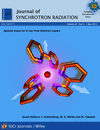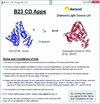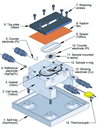issue contents
May 2015 issue
Special issue on X-ray Free-Electron Lasers
Guest Editors: Ilme Schlichting, William E. White and Makina Yabashi

Cover illustration: Spin transition in the iron complex [FeII(bpy)3]2+ (see Chollet et al., pages 503-507). After light excitation the molecule undergoes several electronic transitions and populates a metastable high spin state with expanded molecular geometry within less than 200 fs. Using the ultrashort time structure of free-electron laser pulses, the electronic and structural properties of the complex during this transitions can be studied by X-ray spectroscopy.
facility information
free-electron lasers
Free 

This issue of the Journal of Synchrotron Radiation is a special issue on X-ray free-electron lasers. Here, a brief introduction to these special issue papers is given.
Open  access
access
 access
accessThe present status of the Linac Coherent Light Source as a user facility is presented. Opportunities and challenges as well as the scientific impact of X-ray free-electron lasers are discussed.
Open  access
access
 access
accessAn overview of SACLA operating as a user facility is presented. An updated status of the light source and the beamline is summarized. Key scientific achievements reported in 2013 and 2014 and the main experimental systems are reviewed. A perspective of the facility upgrade is given.
Coherent FEL sources in the VUV and soft X-ray spectral range are presented.
Open  access
access
 access
accessA description of the Atomic, Molecular and Optical Sciences (AMO) instrument at the Linac Coherent Light Source is presented. Recent scientific highlights illustrate the imaging, time-resolved spectroscopy and high-power density capabilities of the AMO instrument.
Open  access
access
 access
accessA description of the Soft X-ray Research instrument (SXR) at the Linac Coherent Light Source is given. Recent scientific highlights illustrate the wide variety of experiments and detectors that can be accommodated at SXR.
Open  access
access
 access
accessA description of the X-ray Pump–Probe (XPP) instrument at the Linac Coherent Light Source. is presented. Recent scientific highlights illustrate the versatility and the time-resolved X-ray diffraction and spectroscopy capabilities of the XPP instrument.
Open  access
access
 access
accessA description of the X-ray Correlation Spectroscopy instrument at the Linac Coherent Light Source is presented. Recent highlights illustrate the coherence properties of the source as well as some recent dynamics measurements and future directions.
Open  access
access
 access
accessDescription of the Coherent X-ray Imaging (CXI) instrument at the Linac Coherent Light Source. Recent scientific highlights illustrate the femtosecond crystallography, high power density and extreme matter capabilities of the CXI instrument.
Open  access
access
 access
accessA description of the Matter in Extreme Conditions instrument at the Linac Coherent Light Source is given. Recent scientific highlights illustrate phase-contrast imaging of shock waves, X-ray Thomson scattering and X-ray diffraction of shocked materials.
Open  access
access
 access
accessThis manuscript serves as a reference to describe the optical laser sources and capabilities at the Linac Coherent Light Source.
Open  access
access
 access
accessAn experimental platform for serial femtosecond crystallography using an X-ray free-electron laser and its applications at SACLA are described.
Open  access
access
 access
accessA description of the LDM beamline of FERMI is given, with a detailed description of the photon transport.
The experimental station at the DiProI beamline exploits the unique features of the seeded FERMI-FEL for performing a wide range of static and dynamic scattering studies using various experimental set-ups.
The Elastic and Inelastic Scattering beamline at the free-electron laser FERMI is presented. Scientific objectives, instrument layout and first results are given.
The photon transport and diagnostics system of FERMI (PADReS) is endowed with online and shot-to-shot diagnostics giving information about intensity, spatial-angular distribution, spectral content, as well as other diagnostics to determine coherence, pulse length etc. Moreover, it can manipulate the beam in terms of intensity and optical parameters. A general description of the system is given, together with some selected results from the commissioning/operations/user beam time.
Open  access
access
 access
accessA data acquisition system for X-ray free-electron laser experiments has been developed at SACLA. The system was designed for reliable shot-to-shot data storage with a high data stream greater than 4 Gbps and massive data analysis.
Open  access
access
 access
accessThis paper offers an overview of area detectors developed for use at the Linac Coherent Light Source (LCLS) with particular emphasis on their impact on science. The experimental needs leading to the development of second-generation cameras for LCLS are discussed and the new detector prototypes are presented.
Open  access
access
 access
accessA procedure to correct signal-dependent nonlinear signal distortions in an area detector is introduced and tested on diffuse scattering signals measured at a free-electron laser.
Open  access
access
 access
accessThe current status and prospective applications of nanofocusing for X-ray free-electron lasers are presented.
Open  access
access
 access
accessAn application of speckle size analysis for characterizing the focus at a free-electron laser source is presented. The performance of the speckle-based beam focus diagnostic is also compared with other common focus characterization techniques.
Open  access
access
 access
accessA gas monitor detector was implemented and characterized at the Soft X-ray Research instrument (SXR) to measure the average, absolute and pulse-resolved photon flux of the LCLS beam in the energy range between 280 and 2000 eV.
Open  access
access
 access
accessA description of hard X-ray photon-in photon-out spectroscopy techniques for X-ray free electron laser applications is given. A discussion of the instrumentation suitable for taking full advantage of these new sources and a description of recent measurements performed and related examples are also presented.
Open  access
access
 access
accessThis paper describes new instrumentation developments at the LCLS for materials studies using THz laser excitation and resonant soft X-ray scattering.
Open  access
access
 access
accessA demonstration of multiplexing the LCLS beam by spectral division using a near-perfect diamond thin-crystal monochromator is presented.
Open  access
access
 access
accessSerial operation of FEL experiments was performed using the spent beam typically discarded after passing through a hole in a detector. The beam profile was characterized and results for two simultaneous experiments are reported.
Effects of self-seeding and crystal post-selection on the quality of Monte Carlo-integrated SFX data
The effects of various distributions, such as the spectral and unit-cell distributions, on the quality of Monte Carlo-integrated serial femtosecond crystallography data are investigated.
research papers
Open  access
access
 access
accessA novel measurement scheme that allows multiplexed simultaneous measurements from multiple nearby sample volumes is reported.
It is essential but inconvenient to perform high-quality on-line optimization for synchrotron radiation beamlines. To solve this problem, a general method based on the genetic algorithm for automatic beamline optimization is introduced.
Open  access
access
 access
accessDetails of an original design of a bendable parabolic cylinder collimating X-ray mirror with active temperature stabilization are presented. The design grants assembly without spurious stresses, optimal alignment and shaping of the mirror. A motorized sagittal motion allows new areas of the mirror to be used when the current area is damaged or contaminated.
Open  access
access
 access
accessBy providing the capabilities for high-resolution, high-energy and time-resolved powder X-ray diffraction, beamline P02.1 is a versatile tool to tackle various problems in materials science, crystallography and chemistry.
The upgraded INS endstation of the InterFace beamline IF-BM32 at the ESRF is presented.
Open  access
access
 access
accessThe count rate behaviour of PILATUS3 detectors has been characterized for seven bunch modes at four different synchrotrons. The instant retrigger technology of the PILATUS3 application-specific integrated circuit is found to reduce the dependency of the required rate correction on the synchrotron bunch mode. The improvement of using bunch mode specific rate corrections based on a Monte Carlo simulation is quantified.
Open  access
access
 access
accessThe concept of a two-dimensional multichannel electron spin detector based on Mott scattering and imaging-type electron optics is presented. The efficiency increase of about four orders of magnitude opens new scientific fields including buried magnetic interfaces.
Simultaneous wide-angle X-ray scattering and scanning nanocalorimetric measurements are performed during the thermal processing of thin-film bilayers of Pd/a-Si to form Pd2Si.
Synchrotron radiation Mössbauer spectra of a rotating absorber and its application for testing time dilation and Einstein's Clock Hypothesis are presented.
Open  access
access
 access
accessX-rays only when you want them: optimized pump–probe experiments using pseudo-single-bunch operation
The first use of pseudo-single-bunch pulse picking in time-resolved experiments at the Advanced Light Source is reported. The pseudo-single-bunch technique improves signal to noise and drastically reduces dose-induced sample damage.
An apparatus specially designed for in situ XAS measurements of liquid phase reactions is presented, which allowed the changes in the Pt L3-edge to be monitored during the formation of Pt nanoparticles in aqueous solution.
Open  access
access
 access
accessThe performance of the spectroscopic LEEM-PEEM experimental station at the ALBA Synchrotron is presented: XPEEM lateral resolution down to better than 20 nm, electron energy resolution below 0.15 eV, and excellent long-term stability.
The presented results show the comparative results in interface mixing under 30 keV Ga+ ion irradiation of ultrathin trilayers Pt/Co/Pt and Pt/Co/Au and their influence on the amplitude of magnetic anisotropy.
Open  access
access
 access
accessThe development of a novel experimental capability of nuclear resonant inelastic X-ray scattering at high pressure and low temperature is presented. The new capability is demonstrated by studying the Fe-specific phonon density of states and magnetism in Eu57Fe2As2.
This paper updates an approach to high-resolution X-ray emission spectroscopy that uses a microcalorimeter detector array of superconducting transition-edge sensors (TESs). TES arrays are discussed and compared with conventional methods.
Open  access
access
 access
accessSoft X-ray micro-ARPES measurements have successfully been applied to band mapping of the strongly correlated metallic V2O3.
Hard X-ray lithography using an X-ray nano-beam focused by a Fresnel zone plate is demonstrated to be capable of achieving a patterning resolution better than 25 nm at E = 7.5 keV.
The presented techniques simplify the sampling process and information retrieval algorithm in diffraction enhanced imaging. They also allow improvements of fast imaging researches using synchrotron radiation.
Open  access
access
 access
accessA speckle suppression device containing highly porous nanoberyllium is proposed for manipulating the spatial coherence length and removing undesirable speckle structure during imaging experiments.
Open  access
access
 access
accessBuilding on previous work, a phase-preserving bent Laue beam-expanding monochromator was developed with the capability of performing live animal phase contrast dynamic imaging at the Biomedical Imaging and Therapy beamline at the Canadian Light Source.
A novel method for dual-energy X-ray analysis is tested against mono-energetic CT measurements with dilute salt solutions, and delivers volumetric maps representing electron density and the fourth statistical moment that describes elemental composition. The results are combined with models for the X-ray linear attenuation coefficient and mass energy absorption coefficient to predict interaction coefficients at photon energies 10 keV to 20 MeV, with applications for calculating attenuation correction and radiation absorbed dose.
Open  access
access
 access
accessWater window ptychographic coherent diffractive imaging was demonstrated at the P04 beamline of PETRA III synchrotron radiation source. The beam coherence was characterized with the non-redundant array method.
beamlines
Open  access
access
 access
accessJEEP is a high-energy (50–150 keV) multi-purpose beamline offering polychromatic and monochromatic modes. It can accommodate large samples and experimental rigs, enabling in situ studies using radiography, tomography, energy-dispersive diffraction, monochromatic and white-beam two-dimensional diffraction/scattering and small-angle X-ray scattering.
XAFCA, a new X-ray absorption fine-structure spectroscopy beamline for fundamental and applied catalysis research, built by the Institute of Chemical and Engineering Sciences and the Singapore Synchrotron Light Source, is presented.
Open  access
access
 access
accessUV-CD12 at ANKA and its current end-station are described, with a standard module for vacuum-UV synchrotron radiation circular dichroism of bio-macromolecules in the liquid state, and a unique module for macroscopically oriented lipid membranes (oriented circular dichroism).
computer programs
Open  access
access
 access
accessDAWN is a generic data analysis software platform that has been developed for use at synchrotron beamlines for data visualization and analysis. Its generic design makes it suitable for use in a range of scientific and engineering applications.
laboratory notes
A homemade mirror for X-rays has been built to prepare a diffraction beamline for liquid surface diffraction and scattering measurements.
addenda and errata
Open  access
access
 access
accessFree 

current events
Free 



 journal menu
journal menu














































































